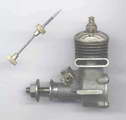A Forgotten Japanese Range:
The Hope Engines
by Adrian Duncan
Chapter 5—The Hope .09 Model
We conclude our series on the Hope range with a necessarily brief look at another of the more elusive Hope models—the "Super" .09 design. This was one of the final offerings of the Hope company and arrived on the scene relatively late. Examples are few and far between—indeed, we don't have access to one ourselves at the present time, and we only have a single image. Still, in the interests of presenting a complete survey of the known Hope models, we'll do what we can.
Based on the attention paid to the .099 displacement category by Japanese manufacturers of model aero engines during the first post-WW2 decade, it would appear that the .099 cu. in. displacement category enjoyed a very high level of customer support in the Asian markets in which the Hope engines primarily competed. Indeed, the .099 category seems to have come to occupy the same major market niche in Japan which the .049 models did in the 1950's American market. Certainly, a surprising number of Japanese makers were early in the field with .099 models, notably Mamiya and Fuji. OS re-joined the .099 party in 1950, the makers of the almost-forgotten Boxer range threw their hats into the ring in around 1951, KO added their own design to the list in 1953 and Enya was actually a Johnny-come-lately among Japanese manufacturers in this displacement category, waiting until May 1954 to launch their own initial .099 model, the excellent Enya 09 Model 3001.
By contrast, the .049 displacement category was largely ignored by Japanese manufacturers in the 1950's, only Fuji and the ultra-obscure Roc and Haru companies producing .049 models during that period. Of these, the Fuji offerings were by far the most popular.
This being the case, it's rather odd that at present there's currently no persuasive evidence of Hope having entered the .099 market prior to late 1954 or perhaps even 1955. By this time the market was pretty well saturated with established products in this category and Hope must have faced an uphill struggle. So it's odd that they waited this long to move in. We have encountered a few .099 models that appeared at first glance to be possible candidates for identification as early Hope products, but upon more detailed study serious objections have emerged in each case. We have chosen to confine this survey to the single model which can unquestionably be attributed to the Hope Engineering Company.
We saw in our earlier chapters on the larger Hope models that the "Super" versions of the .19 and .29 engines seem to have begun to appear in late 1953 or thereabouts. Such evidence as we've been able to uncover to date suggests that the .09 model arrived some time later. Certainly, Peter Chinn's 1954 international glow engine survey (Model Aircraft May 1955) contains no reference to any Hope .09 model, although both the .19 and .29 models are included.
However it's clear that before ending their involvement with model engine production, Hope did make one effort in the .09 class. This took the form of an .09 version of their contemporary "Super" series which also included the previously mentioned .19 and .29 cu. in. models. The .09 cuin version of this engine was mentioned in the survey of the world's model engines published in early 1958 in the book Model Aero Engine Encyclopaedia, but actual examples are almost never seen outside of Japan.
We don't presently have access to an example of this little-known model. However, thanks to the kindness of David Owen, we are at least able to present an image of this engine. This image shows that this neat little .09 glow-plug engine was very much in step with the other Hope "Super" models in design terms. It featured the same blend of a one-piece die-cast matte-finished crankcase with the backplate secured by four screws, together with a cylinder having integral cooling fins and a separate finned alloy head. The cylinder/head assembly was secured in exactly the same manner as on the larger engines, using two short and two long screws. A further similarity was the left-side location of the exhaust stack.
Bore and stroke of this very elusive model were given in the 1958 survey as a "square" 12.7 mm by 12.7 mm for a displacement of 1.61 cc. The weight was given as a commendably light 1.75 ounces, comparable to that of the contemporary Mamiya .099. Operating speed range was given as 8,000—14,000 rpm. In the absence of an actual example to examine, we are unable to provide more specific information at this time.
This was among Hope's final products. As mentioned in earlier chapters, production of all Hope models appears to have ceased at some intermediate point in the latter part of the 1950's, most likely in around 1957. It's true that the range was mentioned in the 1958 survey noted above, but inclusion in that list cannot be taken as conclusive evidence of ongoing production as of 1958—a number of other engines on the list were unquestionably out of production by that time.
This page designed to look best when using anything but IE!
Please submit all questions and comments to
[email protected]
|
Unless otherwise expressed, all original text, drawings, and photographs created by
Ronald A Chernich appearing on the Model Engine News web site are licensed under a Creative Commons Attribution-Noncommercial-Share Alike 3.0 License. |

|


